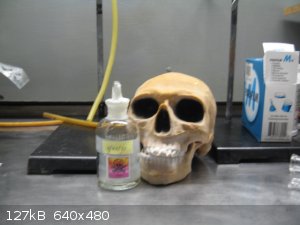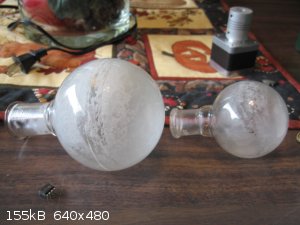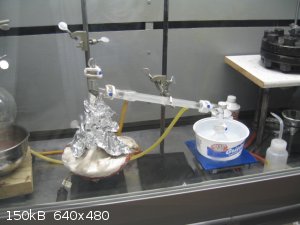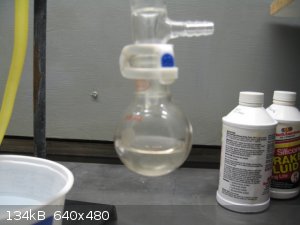| Pages:
1
..
5
6
7
8 |
Picric-A
National Hazard
   
Posts: 796
Registered: 1-5-2008
Location: England
Member Is Offline
Mood: Fuming
|
|
If you dont have the equiptment to make SO3/Oleum then you certainly dont have the equiptment to use/store it safely SO DONT!
|
|
|
D S2 A
Harmless

Posts: 16
Registered: 7-1-2010
Location: Brazil
Member Is Offline
Mood: No Mood
|
|
I simply do not have equipment suitable to very high temperatures or pressurise the reaction vessel, Picric-A. The oleum shall be stored only for a
day. The stumbling block for me is just related to elevated temperatures like 600 ºC.
Best regards, Dúlio.
Do not compare you to others but with the best that yourself can do.
|
|
|
Picric-A
National Hazard
   
Posts: 796
Registered: 1-5-2008
Location: England
Member Is Offline
Mood: Fuming
|
|
600 can easily be reached by a bunsen burner... or any gas burner for that matter.
Learn to walk before you can run.
|
|
|
D S2 A
Harmless

Posts: 16
Registered: 7-1-2010
Location: Brazil
Member Is Offline
Mood: No Mood
|
|
Even a candle goes above 1.000 ºC, Picric-A. The matter for me is how to build a reaction vessel able to resist such temperatures.
If it not bothers you, add me on MSN.
Best regards, Dúlio.
[Edited on 7-1-2010 by D S2 A]
Do not compare you to others but with the best that yourself can do.
|
|
|
Picric-A
National Hazard
   
Posts: 796
Registered: 1-5-2008
Location: England
Member Is Offline
Mood: Fuming
|
|
True.. but i would like to see you try heating half a gram of (say...) sand to 1000 degC with a candle...
Ps. I cannot go on MSN here (it is blocked by the school grr.) so if you want to contact me use U2U)
[Edited on 7-1-2010 by Picric-A]
|
|
|
D S2 A
Harmless

Posts: 16
Registered: 7-1-2010
Location: Brazil
Member Is Offline
Mood: No Mood
|
|
It is just an example, Picric-A. 
Best regards, Dúlio.
Do not compare you to others but with the best that yourself can do.
|
|
|
hissingnoise
International Hazard
    
Posts: 3940
Registered: 26-12-2002
Member Is Offline
Mood: Pulverulescent!
|
|
This may be of interest.
http://www.google.com/patents?hl=en&lr=&vid=USPAT391...
In section 4 the patentee states that, by electrolysis, the concentration of dilute H2SO4 can be brought to 100% and above.
It is presumed that above 100% means oleum. . .
The downside is that platinum electrodes work best.
|
|
|
D S2 A
Harmless

Posts: 16
Registered: 7-1-2010
Location: Brazil
Member Is Offline
Mood: No Mood
|
|
Unfortunately I do not have either equipment nor knowledge do deal with electrolysis. Any other idea?
Best regards, Dúlio.
Do not compare you to others but with the best that yourself can do.
|
|
|
matt
Harmless

Posts: 2
Registered: 15-12-2011
Member Is Offline
Mood: No Mood
|
|
Stoichiometric Magnesium Sulfate and Sodium Pyrosulfate
Hi, this is my first post on this site. The process was carried out some 6 months ago, and I've since lost the photos and product.
1 mole (or proportion) of anhydrous Sodium Pyrosulfate (Na2S2O7) {prepared by thermal decomposition of Sodium Persulfate (Na2S2O8)} and 1 mole (or
proportion) of anhydrous Magnesium Sulfate (MgSO4) {prepared by heating Epsom Salts (MgSO4.7H2O) at c. 250'C for several hours} were finely ground and
mixed using mortar and pestle and the resulting white powder placed in a small retort. Heating over LPG burner flame resulted in a gradual rising,
swelling and a change in colour to a metallic grey (similar to lead (a little whiter) or many amalgamated metals). Up to this point no fumes or
condensation were observed. After effectively total conversion to this spongy-appearing, grey form, a clear liquid began to distill off and was
collected in concentrated Sulfuric Acid (H2SO4). A weight gain corresponding to 0.8 mole (or proportion) of sulfur trioxide (SO3) was measured at the
completion of the distillation run. When the receiver was removed from the end of the condenser, white fumes with an acrid smell developed from the
clear liquid present at the end of both joints.
(The amounts involved in the run I describe correspond to an actual yield of 16g SO3 out of a theoretical 20g, I wont specify the weights of starting
materials as I would be extrapolating, however I remember the yield values very clearly. The vessel was a 125ml retort [just like a retort is meant to
look] with the condenser mounted in a 2 liter plastic bottle full of ice water [refreshed at about room temperature] and the burner was an LPG
hotplate burner such as sold in camping stores for connection to a 9kg LPG or propane bottle.)
This is it for the moment, an attempt to convert to Thionyl Chloride failed and I lost what I had left. The system I was working with reaches a
maximum internal temperature in the high 400'Cs as best i know and the late onset of distillation suggests to me the absence of any unrecognised water
of crystallisation. I found this procedure to be accessible and productive to an extent beyond the others I came by in this forum. Owing to the fact
that it remains merely an interpretation of the vague procedures outlined in the German patents already referenced in this thread, I felt that this
was the right place to share this. I hope this is useful to somebody, even if I have misinterpreted the results.
This is only the beginning of a response to the stimulus I have gained from the pages of ScienceMadness and I will endeavour to share more of the
developments which lead on specifically from ideas which arose out of this forum.
Thanks, Matt.
[Edited on 15-12-2011 by matt]
|
|
|
AndersHoveland
Hazard to Other Members, due to repeated speculation and posting of untested highly dangerous procedures!
    
Posts: 1986
Registered: 2-3-2011
Member Is Offline
Mood: No Mood
|
|
Sulphur trioxide reacts with nitrogen pentoxide in carbon-tetrachloride solution, with the formation of a crystalline precipitate melting at 124° to
128° C., which is probably (SO3)4.N2O5:
|
|
|
elementcollector1
International Hazard
    
Posts: 2684
Registered: 28-12-2011
Location: The Known Universe
Member Is Offline
Mood: Molten
|
|
Quote: Originally posted by matt  | | 1 mole (or proportion) of anhydrous Sodium Pyrosulfate (Na2S2O7) {prepared by thermal decomposition of Sodium Persulfate (Na2S2O8)} and 1 mole (or
proportion) of anhydrous Magnesium Sulfate (MgSO4) {prepared by heating Epsom Salts (MgSO4.7H2O) at c. 250'C for several hours} were finely ground and
mixed using mortar and pestle and the resulting white powder placed in a small retort. Heating over LPG burner flame resulted in a gradual rising,
swelling and a change in colour to a metallic grey (similar to lead (a little whiter) or many amalgamated metals).[Edited on 15-12-2011 by matt]
|
A metal? There's only one metal in that mix as far as I can tell, and I don't think it'd form this easily.
Elements Collected:52/87
Latest Acquired: Cl
Next in Line: Nd
|
|
|
madscientist
National Hazard
   
Posts: 962
Registered: 19-5-2002
Location: American Midwest
Member Is Offline
Mood: pyrophoric
|
|
Quote: Originally posted by AndersHoveland  | Sulphur trioxide reacts with nitrogen pentoxide in carbon-tetrachloride solution, with the formation of a crystalline precipitate melting at 124° to
128° C., which is probably (SO3)4.N2O5:
|
The addition of sulfur trioxide to carbon tetrachloride is one of the early phosgene preparations.
I weep at the sight of flaming acetic anhydride.
|
|
|
matt
Harmless

Posts: 2
Registered: 15-12-2011
Member Is Offline
Mood: No Mood
|
|
Yes, I recently repeated this procedure, on a larger scale (1 molar), this time only getting a 50% yield although on the upside my glassware didn't
crack from the heat. The metallic color, I believe, is carbonisation of impurities in the pool chemical grade reagents I used, the melt returned to
white on continued heating although I'm not sure if that contradicts my idea of carbonised impurities. IIRC, the article which listed results for
various alkali and alkaline earth metal pyrosulfates nominated lithium as the most easily thermally decomposed. Large amounts of Lithium Sulfate might
require some effort to arrange, but hopefully the Lithium itself could be recovered from post-reaction by-products by some sort of metathesis. From my
understanding of pyrosulfates, an anhydrous lithium pyrosulfate would probably be more difficult to obtain than the oleum to be produced from the
combination of Na2S2O7 and Li2SO4. This is the direction I hope to take it in next as neither 50% yields nor one-time sacrificial glassware seem
efficient enough to me to consider oleum as a first choice where other reagents are suitable.
|
|
|
S.C. Wack
bibliomaster
    
Posts: 2419
Registered: 7-5-2004
Location: Cornworld, Central USA
Member Is Offline
Mood: Enhanced
|
|
Quote: Originally posted by matt  | | IIRC, the article which listed results for various alkali and alkaline earth metal pyrosulfates nominated lithium as the most easily thermally
decomposed. |
Just last week I looked up the abstract for the lithium pyrosulfate -> SO3 temp. article by Spitsyn IIRC, CA 20435 (1960)...the long abstract gave
the impression that Gmelin's may have taken the figure out of context, not surprising considering the quoted temp...there may be measurable losses....
|
|
|
halogen
Hazard to Others
  
Posts: 372
Registered: 18-4-2004
Member Is Offline
Mood: No Mood
|
|
"Bismuth sulfate (Bi2(S04)3) is found in the form of white hygroscopic
crystals, which readily decompose in water to give basic subsulfate and
dissolve without decomposition in aqueous sulfuric acid. Above 465°C, it is
converted to the oxide under the liberation of sulfur trioxide."
Organic Bismuth Chemistry Hitomi Suzuki
TYPO?
|
|
|
Agricola
Harmless

Posts: 42
Registered: 28-10-2013
Location: Brazil
Member Is Offline
Mood: No Mood
|
|
For a preparation of SO3 from P4O10 and H2SO4, see the attached paper by Evans. Notice Evans calls SO3 and P4O10 "anhydrous sulfuric acid" and
"anhydrous phosphoric acid". Today we would call them acid anhydrides not anhydrous acids.
Attachment: sulfur_trioxide_evans1848.pdf (358kB)
This file has been downloaded 935 times
|
|
|
Magpie
lab constructor
    
Posts: 5939
Registered: 1-11-2003
Location: USA
Member Is Offline
Mood: Chemistry: the subtle science.
|
|
Today I made 2-3ml of oleum using the procedure of CD-ROM-LAUFWERK as presented by garage chemist. This is an extremely facile method. Phosphoric
acid is first dewatered to metaphosphoric acid (HPO3) under strong heat. This then dewaters the H2SO4 to SO3.
The hot phosphoric acid severely corrodes the 100 mL rbf but garage chemist says NaOH will remove this.

[Edited on 27-9-2017 by Magpie]
[Edited on 27-9-2017 by Magpie]
[Edited on 27-9-2017 by Magpie]
The single most important condition for a successful synthesis is good mixing - Nicodem
|
|
|
hissingnoise
International Hazard
    
Posts: 3940
Registered: 26-12-2002
Member Is Offline
Mood: Pulverulescent!
|
|
| Quote: | | Phosphoric acid is first dewatered to metaphophoric acid (HPO3) under strong heat. This is then dewatered to SO3. |
Didn't know (HPO3) was such a strong desiccant, tbh, but NaOH will further corrode your already damaged RBF.
|
|
|
Melgar
Anti-Spam Agent
    
Posts: 2004
Registered: 23-2-2010
Location: Connecticut
Member Is Offline
Mood: Estrified
|
|
I've been using KOH a lot lately, since I've been able to get it for about the same price as NaOH. Although it's a stronger base, it has
significantly less of a corrosive effect on glass compared to NaOH. Potassium salts are also much better than sodium salts for salting out an aqueous
layer. There seems to be very little that potassium salts dissolve significantly in besides water.
The first step in the process of learning something is admitting that you don't know it already.
I'm givin' the spam shields max power at full warp, but they just dinna have the power! We're gonna have to evacuate to new forum software!
|
|
|
clearly_not_atara
International Hazard
    
Posts: 2692
Registered: 3-11-2013
Member Is Offline
Mood: Big
|
|
I don't think anything can actually reverse the damage metaphosphoric acid does to glass... you can remove the phosphate, at least, with
alkali. In the future consider preparing your HPO3 in stainless steel.
Pretty cool that metaphosphoric acid can make oleum, though. Chlorosulfonic acid and tosyl chloride become OTC, if only you can find a way to contain
the rxn mixture. Come to think of it, it might be possible to go all the way to TsCl in situ by starting with a mixture of H2SO4 and TsOH,
adding HPO3, and gassing with HCl. If produced successfully, tosyl chloride (s.g. 1.3) will float on top of the rxn mixture (s.g. ~1.8).
[Edited on 27-9-2017 by clearly_not_atara]
|
|
|
Melgar
Anti-Spam Agent
    
Posts: 2004
Registered: 23-2-2010
Location: Connecticut
Member Is Offline
Mood: Estrified
|
|
Is tosyl chloride the same thing as para-toluenesulfonyl chloride? Because I'm pretty sure that's available on Amazon if anyone needs any.
The first step in the process of learning something is admitting that you don't know it already.
I'm givin' the spam shields max power at full warp, but they just dinna have the power! We're gonna have to evacuate to new forum software!
|
|
|
amaming
Harmless

Posts: 5
Registered: 8-9-2017
Member Is Offline
Mood: No Mood
|
|
the grit left on my flask after dehydrating the phosphoric acid stayed on despite me bombarding it with everything I could to try and clean it. If you
want to do the meta phosphoric acid method to oleum, get yourself a 3" copper endcap or a flask you dont mind losing.
|
|
|
Magpie
lab constructor
    
Posts: 5939
Registered: 1-11-2003
Location: USA
Member Is Offline
Mood: Chemistry: the subtle science.
|
|
I was able to remove the grit by refluxing with concentrated KOH solution for a few hours.
edit: No, this did not work. See pictures below:

[Edited on 29-9-2017 by Magpie]
The single most important condition for a successful synthesis is good mixing - Nicodem
|
|
|
Magpie
lab constructor
    
Posts: 5939
Registered: 1-11-2003
Location: USA
Member Is Offline
Mood: Chemistry: the subtle science.
|
|
Today I made another batch of oleum, this time at 4X scale. I used a 600mL beaker for preparing the HPO3 and a 250mL flask for making the oleum. The
yield was excellent at 29.6g vs an estimated 2-3g for the 1X scale.
I should caution that my ground glass joints leaked profusely. Therefore a good fume hood is mandatory.
2 pictures will be posted as soon as I figure out how with my new computer.
 
[Edited on 29-9-2017 by Magpie]
The single most important condition for a successful synthesis is good mixing - Nicodem
|
|
|
Magpie
lab constructor
    
Posts: 5939
Registered: 1-11-2003
Location: USA
Member Is Offline
Mood: Chemistry: the subtle science.
|
|
The NaOH did Not remove the corrosion product from my flasks. See above picture.
The single most important condition for a successful synthesis is good mixing - Nicodem
|
|
|
| Pages:
1
..
5
6
7
8 |